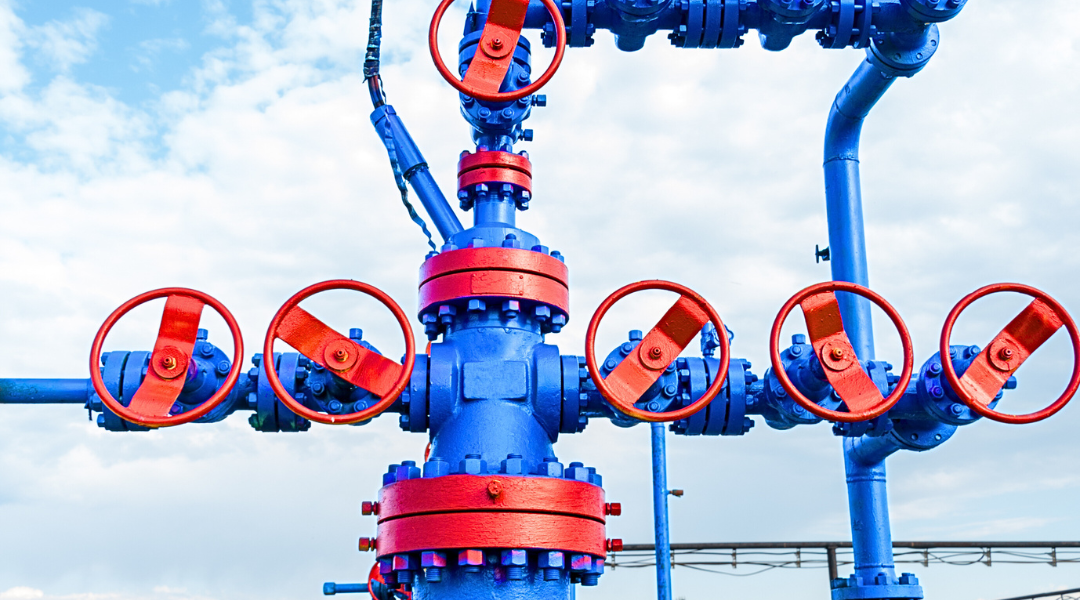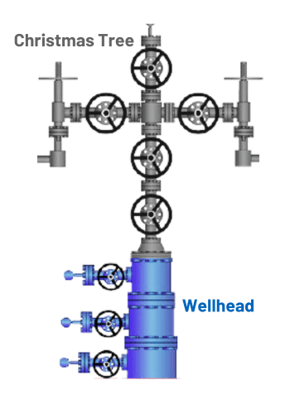
Wellhead or Christmas Tree? What's the difference?
Posted by CDI Products on Aug 30, 2023
The words Christmas Tree and Wellhead are often used interchangeably in the oil and gas industry.
However, a wellhead and a Christmas tree are entirely separate equipment. They are both vital to gas and oil production, and they each have valves and other equipment that aids in controlling and guiding the flow of materials.
A wellhead is necessary to control the pressure during drilling and production. It is located on the surface of the well between the casing and the drilling floor, allowing safe and controlled access to a live well. The wellhead suspends the casing and provides pressure seals for the casing string. It supports the BOP (Blowout Preventer) during drilling, the FRAC Tree during completion, and a Production Christmas Tree after completion. The wellhead is present during the drilling, completion, and production phases.

The Christmas Tree's primary purpose is to control the flow of resources—typically oil or gas—into and out of a well during production. The Christmas tree arrives and is attached to the wellhead after finalizing the drilling process. The Christmas Tree is a series of valves, spools, gauges, and chokes.
A total of five valves are included in a Christmas tree, and each one is designed for a specific function.
Kill Wing Valve: This valve injects fluids like drilling mud or brine into the well to control pressure. It is often used during well interventions and maintenance activities to "kill" the well, meaning to control the pressure and halt the flow of fluids.
Swab Valve: The swab valve is located at the top of the Christmas tree and provides access to the well for a wireline or coiled tubing operation. This allows for well interventions, maintenance, or logging without needing to kill the well. It plays a crucial role in maintenance and troubleshooting operations.
Production Wing Valve: This valve controls the flow of oil and gas from the well to the production facilities. It can be opened or closed to start or stop production, and it's also used to regulate the flow rate to optimize production or manage potential issues like sand production.
Upper Master Valve: The upper master valve is one of the primary isolation valves, which can completely shut off the well's flow. It's typically used in emergency situations to quickly and effectively halt the flow of oil and gas, providing a critical layer of safety and environmental protection.
Lower Master Valve: The lower master valve is another primary isolation valve with functionality similar to the upper master valve. It provides redundancy, ensuring a backup is available to shut off the well if the upper master valve fails for some reason. Having both an upper and lower master valve gives operators more flexibility and enhances safety measures.
Together these components regulate pressure, control flow, and allow access to the wellbore during the completion and production stages of the well. It is named for its resemblance to a decorated tree at Christmas. This vital piece of equipment assists in numerous ways well intervention, pressure relief, chemical injection, well-monitoring, flow composition and rate, valve, choke position feedback, and more.
How are S-Seals and FS-Seals used for Wellheads and Christmas Trees?
CDI manufactures precision-molded S and FS Seals that employ anti-extrusion springs required for high pressures and a broad range of temperatures. S and FS Seals offer maximum extrusion resistance in demanding high-pressure, high-temperature (HPHT) sealing environments. Our S-Seal is well-known as a technologically advanced replacement for traditional three-piece T-Seals or O-Rings with back-ups. A metal garter spring is incorporated into a uniquely designed elastomeric seal element. This enables it to withstand large extrusion gaps (up to .125"). Our FS-Seal is a replacement for S-Seals in applications with large extrusion gaps or where equipment diameters may be inconsistent. The FS-Seal incorporates metal garter springs with a uniquely designed elastomeric seal element. This design is capable of sealing areas where a high degree of seal deflection is necessary to compensate for variations in piping, casing, or large-diameter parts. An FS seal is an ID seal with a thicker cross-section, and they are used for significant extrusion gaps and rougher casing surfaces.
CDI manufactures high-quality custom and industry standard sizes of S and FS seals in NBR, HNBR, and FKM materials to meet our client's unique sealing requirements and quickly supply them throughout their business cycle.
Topic: valves, seals, oil and gas, well completion, upstream, wellhead, christmas tree, drilling
